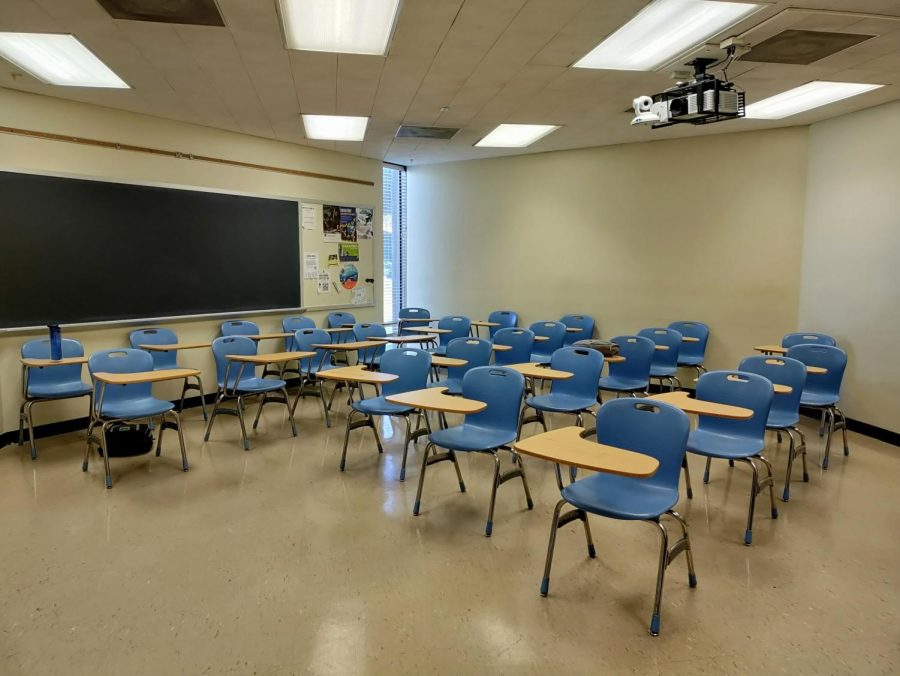Outdated Classrooms may Discourage Students from Returning to Campus
Outdated classrooms in buildings such as Meiklejohn Hall need a face-lift because students’ academic success and overall well-being might depend on it
March 15, 2023
Imagine, two years of little to no socialization and taking all your courses online during the pandemic, and it is your first day back on campus. Excited to see old friends and make new ones, you head to your first class while taking in your surroundings.
After being stuck inside for so long, you are dying for environmental stimulation. While walking you excitedly begin to imagine the classroom and where you will sit – what will it look like? You walk in, and your stomach drops to your ankles.
The walls are different shades of a dirty, dull (what used to be) white and the lighting is dim and drains your energy the minute you enter the room. The chairs are not fit for adults but rather middle school students and are closely arranged in a way that makes it almost impossible to navigate between the aisles.
Would this make you want to come to school in-person to learn? Is it possible that addressing this issue could have an impact on how students feel about learning in general, or whether or not they register for in-person courses?
There have been several authors and academics who have addressed this very question of the relationship between the classroom environment and how it might affect the way in which a student feels and learns.
In their book, Thirty Years of Learning Environments: Looking Back and Looking Forward, David B. Zandvliet and Barry Fraser state, “Various psychosocial and physical aspects of the learning environment can have important impacts on both cognitive and affective outcomes including student satisfaction with learning, academic achievement and self esteem.”
Meiklejohn Hall was built in 1968 and has not been updated in years, which is most apparent in classrooms on the third and fourth floor. Many students have stated that classrooms appear run-down and the overall environment is not conducive to learning.
There are also students who have a difficult time fitting in the middle school-like desks in the classrooms. For some, it can feel like body-shaming when they are unable to fit in these chairs and attention is drawn to them as the class is interrupted to accommodate them.
“People have basically been told to grab a chair from outside and bring it in because they don’t fit, or there are just too many people,” stated senior and biology major Fernando Alarcon, who has taken many classes in Meiklejohn Hall. He continued, “Your environment will help you decide whether you want to continue learning. If you feel like you’re not being welcomed or cared for then why are you here?”
Alarcon concluded that studying in a rundown environment might make someone feel as if their education is inferior which could affect their search for a career later in life.
“What we really want to do in this post-pandemic environment is to do more collaboration in the classrooms. That’s harder to facilitate in the spaces we have right now,” according to Dr. Bridget Ford of the Department of History.
Ford continued, “There are lots of desks instead of tables, it would be nice if students had classrooms that allowed for collaborative learning.” Ford then explained that she goes into her classroom early to move the desks to make it easier for group activities.
Numerous requests for interviews were made to the CSUEB administration but only a single official response was provided by CSUEB’s News and Media Manager, Kimberly Hawkins, “Cal State East Bay is constantly assessing the needs of our students, faculty and staff and working to meet them. That stated, Facilities Development and Operations must balance the public university’s resources with the needs of our campus community as we attend to our two campuses.”
Hawkins’ statement ended with, “We welcome feedback from our students, staff and faculty and want to accommodate the needs of our rich and diverse community and give them the tools to succeed.”
During the two years of the pandemic when all courses were taught online, the University was constructing the new CORE Library building and adding more restaurants in the Old Student Union. Although having access to an updated library and increased food options for students are important components to the college experience, classrooms are the focal point of learning and where students spend most of their time while on campus. Unfortunately, it would seem that CSUEB has put updates to Meiklejohn Hall on the back burner.
This is not the only building that has issues with poor classroom conditions. The Art and Music buildings are also in desperate need of help. Shouldn’t the academic success and overall well-being of CSUEB students be first priority? Furthermore, if CSUEB wants students to continue to register for more in-person classes, this issue might very well have an impact on that. Addressing the issue would benefit both the students and the university as it would make CSUEB a much more comfortable and enjoyable environment to learn.

















